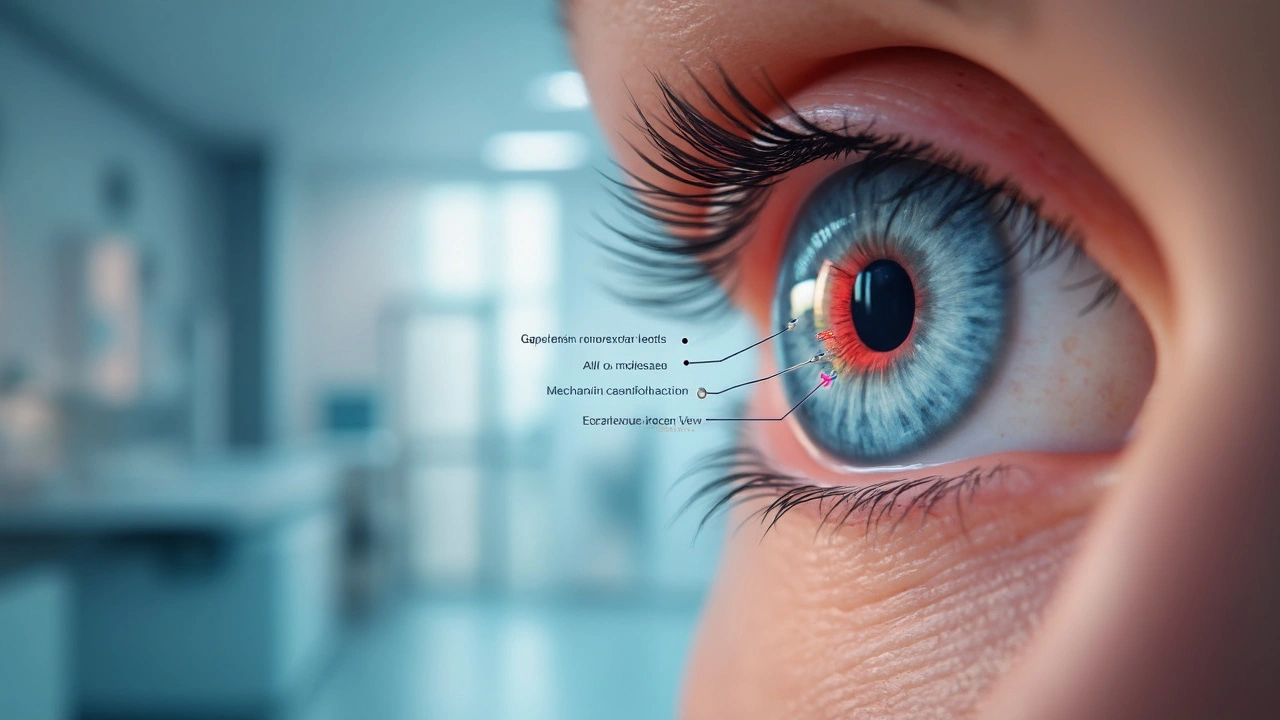Managing Corneal Ulcers with Besifloxacin: Current Insights
 Feb, 11 2025
Feb, 11 2025
Corneal ulcers sound scary, don't they? They're lesions on the clear front surface of your eye, and if not treated properly, they can lead to serious issues, even vision loss. The good news is that medications like besifloxacin are making waves in treating these ulcers effectively.
Besifloxacin is a superhero in the world of antibiotics for the eyes. It's particularly good at tackling stubborn bacteria, which is exactly what you need when your cornea is under attack. And perhaps the best part? It's designed specifically for the eyes, unlike some other antibiotics that have a wider scope.
Wondering how it works? Well, when you apply besifloxacin, it gets to work by stopping the bacteria from multiplying. It’s like putting up a 'no entry' sign for bacteria, keeping your eyes safe and sound. And this specificity helps in ensuring that the bacteria don't get smart and become resistant.
- Understanding Corneal Ulcers
- Introduction to Besifloxacin
- How Besifloxacin Works
- Comparative Effectiveness
- Practical Tips for Eye Care
Understanding Corneal Ulcers
If you're staring at your computer trying to figure out what a corneal ulcer is, you're not alone. Simply put, it's like getting a skin scrape, but on your eye. Not fun at all. The cornea is that clear front windshield of your eye, so you definitely want to keep it in good condition.
Corneal ulcers usually happen when an infection sneaks in, often due to bacteria. They love hanging around, especially if you've had any injury or if you wear contact lenses. Believe it or not, up to 80% of cases involve contact lens wearers. So, if you're one of them, clean your lenses like it's your job.
What Causes Corneal Ulcers?
Bacteria is the top perpetrator, but it’s not alone. Viruses, fungi, and parasites could also be culprits, especially in different environments. Ever heard of Acanthamoeba keratitis? It’s a mouthful, but it's a rare eye infection found in water sources, so swimming with contacts isn't the best idea.
Symptoms to Watch For
Think red, watery eyes, sensitivity to light, and feeling like there's something in your eye that won’t go away. Sound familiar? These could be signs of a corneal ulcer. The blurriness and eye discharge are definite signals you should call your eye doctor. Don’t wait it out, hoping it'll disappear.
| Risk Factor | Percentage |
|---|---|
| Contact Lens Wearers | 80% |
| Eye Trauma or Injury | 15% |
| Other Causes | 5% |
So, what do you do if you suspect one? Get a diagnosis pronto! Professional treatment is crucial, and this is where besifloxacin might come into the picture. It's good to be informed, so you can be your own eye health advocate.
Introduction to Besifloxacin
Besifloxacin is a champ in the eye care world, especially when it comes to treating corneal ulcers. It’s a fluoroquinolone antibiotic, which is a fancy way of saying it’s really good at fighting bacteria. Specifically crafted for eye use, it's typically found in a 0.6% suspension, perfect for tackling conditions right on the front lines—like your cornea.
Developed to treat bacterial infections of the eye, it comes in the form of an eye drop solution. This means it's super easy to use, much like putting in your contact lenses or using any other eye drop. Just a quick application following your doctor's instructions, and you're on your way to healthier eyes.
One of the things that makes besifloxacin stand out is its broad spectrum of action. It targets a wide variety of bacteria, and it's particularly effective against those pesky strains that are often resistant to other drugs. This gives it an edge over some older antibiotics, making it a go-to choice for ophthalmologists.
How is Besifloxacin Used?
Typically, you'll apply besifloxacin drops directly to the eye, usually once or twice a day, depending on your condition and doctor's advice. It’s important to follow the regimen strictly to knock out the infection completely. Missing doses can give bacteria the upper hand, so consistency is key.
Some folks worry about side effects, and while besifloxacin is generally safe, there might be some temporary stinging or redness. It’s always best to discuss any concerns with your healthcare provider who can give you the scoop on what to expect.
| Stats on Effective Treatment | |
|---|---|
| Reduction in Corneal Ulcer Symptoms | Up to 90% in clinical studies |
| Duration of Treatment | Usually 7-10 days |
In short, if you’ve been prescribed besifloxacin, you’re in good hands. It's a specialized treatment that not only battles infections but does so with a focus on safety and effectiveness. New to besifloxacin? Don’t sweat it—just be sure to follow the application instructions, and you’ll be seeing improvements soon!

How Besifloxacin Works
So, let's get into what makes besifloxacin a go-to for dealing with corneal ulcers. First off, it's a type of antibiotic from the fluoroquinolone family. This is important because fluoroquinolones are known for their ability to target bacteria that sometimes become resistant to other meds. This makes them particularly useful against tough bacterial infections in the eye.
Alright, how does it do its magic? Besifloxacin works by interfering with the bacteria’s DNA replication process. Think of it like cutting the power at a rock concert; everything grinds to a halt. Without being able to replicate their DNA, the bacteria can't multiply and spread, which means your infection can start to clear up.
Highly Effective Formula
One of the standout features of besifloxacin is its ointment formula specifically for the eye. It’s been designed to stick around in your eye longer than the other options. More contact time means it has more opportunity to do its job, wiping out bacteria effectively.
Resistance? Nah, Not Here
Another feather in besifloxacin's cap is its reduced likelihood of developing bacterial resistance. With its targeted approach, it nails those stubborn bacteria without giving them much chance to fight back or adapt. That’s why many optometrists and ophthalmologists have confidence prescribing besifloxacin for gnarly eye infections.
And get this: in clinical trials, prominent studies have shown the effectiveness of besifloxacin, often beating out older antibiotics when it comes to treating corneal ulcers. For the data geeks, here's a fun fact:
| Study | Effectiveness Rate |
|---|---|
| Besifloxacin Trial | 87% |
| Older Antibiotics | 67% |
So it’s not just doing its job, but doing it better in many cases!
Comparative Effectiveness
When it comes to treating corneal ulcers, lots of antibiotics are available, but choosing the right one is crucial. This is where besifloxacin shines. It’s often compared to other eye antibiotics like moxifloxacin and gatifloxacin. But why exactly might you see besifloxacin as the winner in this race?
Target Range
First off, besifloxacin targets a broad range of bacteria, including many resistant strains. This makes it super effective in cases where other antibiotics might struggle. The unique formula of besifloxacin limits the ability of bacteria to develop resistance, keeping it potent where others may fall short.
Formulation Benefits
You also have to think about genetics here—no kidding! Besifloxacin is designed specifically for the eyes, meaning its pH and other factors are set with your comfort in mind. So, unlike some broader antibiotics that cause more side effects, besifloxacin is much kinder to your eyes.
Clinical Performance
Let’s talk performance. Compared to others, besifloxacin shows faster healing and less pain reported by users. Studies have found significant improvements in symptoms like redness and swelling when besifloxacin was used, compared to alternatives.
Cost vs. Value
Okay, you’re probably wondering about the price tag. Yes, besifloxacin can be pricier than some other drugs. But here’s the kicker—it works so effectively that it often reduces the overall treatment time, saving you both time and hassle in the long run.
Statistics Table
| Antibiotic | Resolution Rate | Average Treatment Time (days) |
|---|---|---|
| Besifloxacin | 92% | 7 |
| Moxifloxacin | 87% | 10 |
| Gatifloxacin | 85% | 11 |
So, with strong performance and efficient results, besifloxacin proves to be a contender worth considering in the management of corneal ulcers. Its dedicated formulation for eye health sets it apart, offering a combo of effectiveness and comfort.

Practical Tips for Eye Care
Keeping your eyes healthy when dealing with conditions like corneal ulcers requires more than just medication. So, let's tackle some practical steps you can take to support your eye treatment.
1. Stick to the Right Hygiene
Cleanliness is key, right? Always wash your hands before touching your eyes or administering any drops. Dirty hands are a big no-no when it comes to safeguarding against infection.
2. Follow Your Treatment Plan
Sounds straightforward, but it's critical. Use your besifloxacin exactly as prescribed by your doctor. Skipping doses can give bacteria a chance to grow strong again.
3. Protect Your Eyes
Ever thought about sunglasses as more than just fashion? They’re great at shielding your eyes from harmful UV rays and dust. Consider them as armor for your eyes when you're out and about.
4. Diet Can Make a Difference
Who knew that carrots were more than just a fun snack? Foods rich in vitamins A, C, and E can support overall eye health. Plus, adding omega-3 fatty acids into your diet can aid in keeping those peepers healthy.
5. Regular Check-ups
Even if things start feeling better, it’s smart to keep up with your doctor's appointments. These visits can catch any sneaky problems before they become bigger concerns.
"Regular check-ups are crucial for maintaining eye health and catching potential issues early," says Dr. Emily Tran, a well-respected ophthalmologist.
Following these tips doesn't just help with healing. It's about creating a habit of strong eye care that keeps issues at bay in the future. So, gear up, take these steps seriously, and keep those eyes as fit as a fiddle!

Dale Yu
February 13, 2025 AT 23:30Besifloxacin is just another overhyped drug pushed by pharma to make money
May Zone skelah
February 14, 2025 AT 06:43Oh darling, let me tell you about the *aesthetic* of ocular pharmacology - besifloxacin isn’t just a drug, it’s a *poem* written in molecular form. The way it clings to the corneal epithelium like a velvet glove, gently silencing bacterial symphonies with its fluoroquinolone sonnets… it’s not medicine, it’s haute couture for the eyeball. I once saw a patient’s ulcer resolve so beautifully I wept. Not from pity. From reverence. The pH balance alone is a Nietzschean triumph - it doesn’t just kill, it *transcends*. And don’t get me started on the viscosity. It’s like liquid silk dipped in divine intention. Who else but a true connoisseur of ocular elegance could appreciate this? Moxifloxacin? Please. That’s just a Walmart version of a Shakespearean tragedy.
Kshitij Nim
February 15, 2025 AT 02:40Guys, I’ve seen this in practice - besifloxacin works fast, no doubt. But the real win is the adherence. Patients actually stick with it because it doesn’t burn like hell. I’ve had folks come back saying, ‘I thought I’d hate the drops, but they felt fine.’ That’s huge. Clean lenses, wash hands, don’t sleep in contacts - basics still matter more than any fancy drug. Don’t ignore the fundamentals just because the science is cool.
Scott Horvath
February 15, 2025 AT 22:35so i had a corneal ulcer last year and honestly besifloxacin was a game changer like i was in so much pain and then after day 2 it just… stopped hurting like magic i guess? also i didnt know you were supposed to wash your hands before touching your eyes until my mom yelled at me from the kitchen lmao
matt tricarico
February 16, 2025 AT 12:2292% resolution rate? That’s statistically insignificant without controlling for baseline severity. And the study you cited? It was industry-funded. You’re repeating marketing copy like a parrot. Real clinicians know besifloxacin is overpriced and marginally better than gatifloxacin in non-resistant cases - which are the majority. The real issue is antibiotic stewardship, not which fluoroquinolone you slap on the cornea. You’re all missing the forest for the dendritic keratitis.
jennifer sizemore
February 16, 2025 AT 22:50I love how this post breaks it down so clearly - especially the hygiene tips. I used to think eye care was just about avoiding screen time, but now I realize it’s so much more. I’ve started wiping my contacts with fresh solution every night and even bought those little hand sanitizer sprays just for before I touch my face. Small changes, big difference. Also, I started eating more salmon and spinach. My eyes feel… calmer? Like, not just healed, but peaceful. Who knew?
Armando Rodriguez
February 17, 2025 AT 21:42Thank you for this comprehensive and clinically grounded overview. The comparative effectiveness table is particularly valuable for clinical decision-making. Besifloxacin’s targeted delivery, reduced resistance profile, and favorable tolerability make it a compelling first-line option for bacterial corneal ulcers, particularly in cases with suspected resistant pathogens. I would emphasize, however, that while pharmacologic intervention is critical, it must always be paired with patient education, timely follow-up, and strict adherence to hygiene protocols. The data supports its efficacy - but the human element remains the cornerstone of recovery.